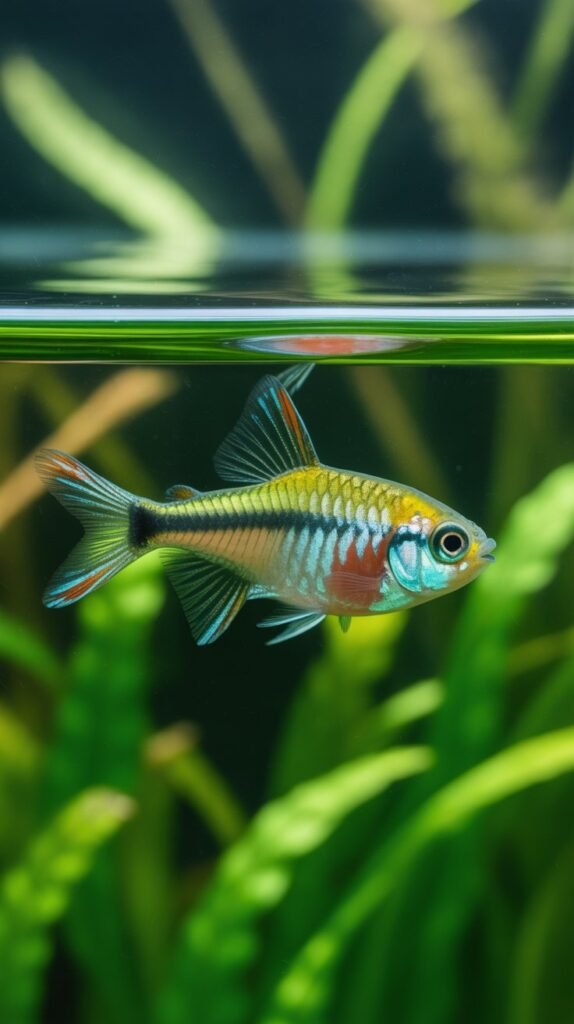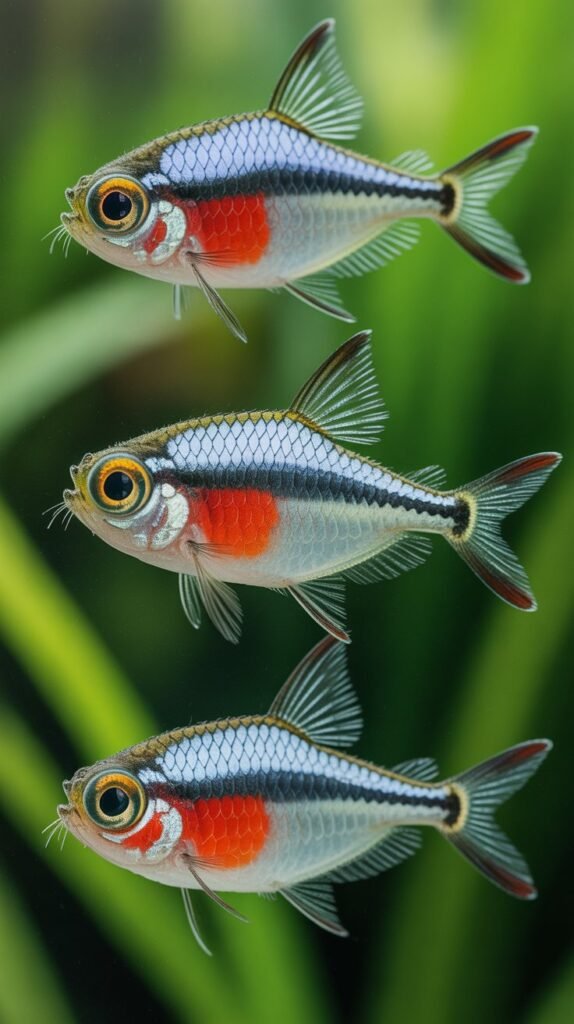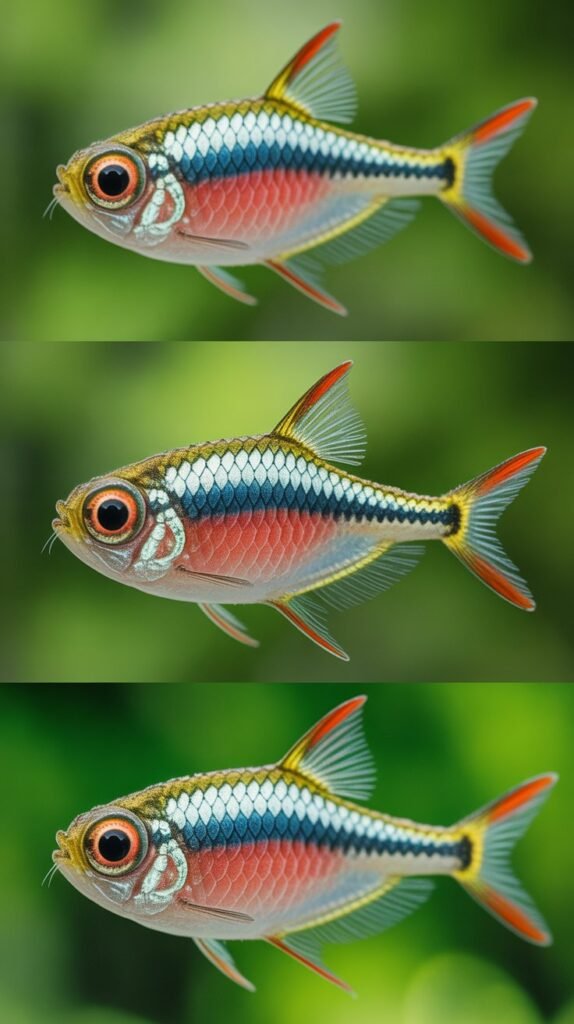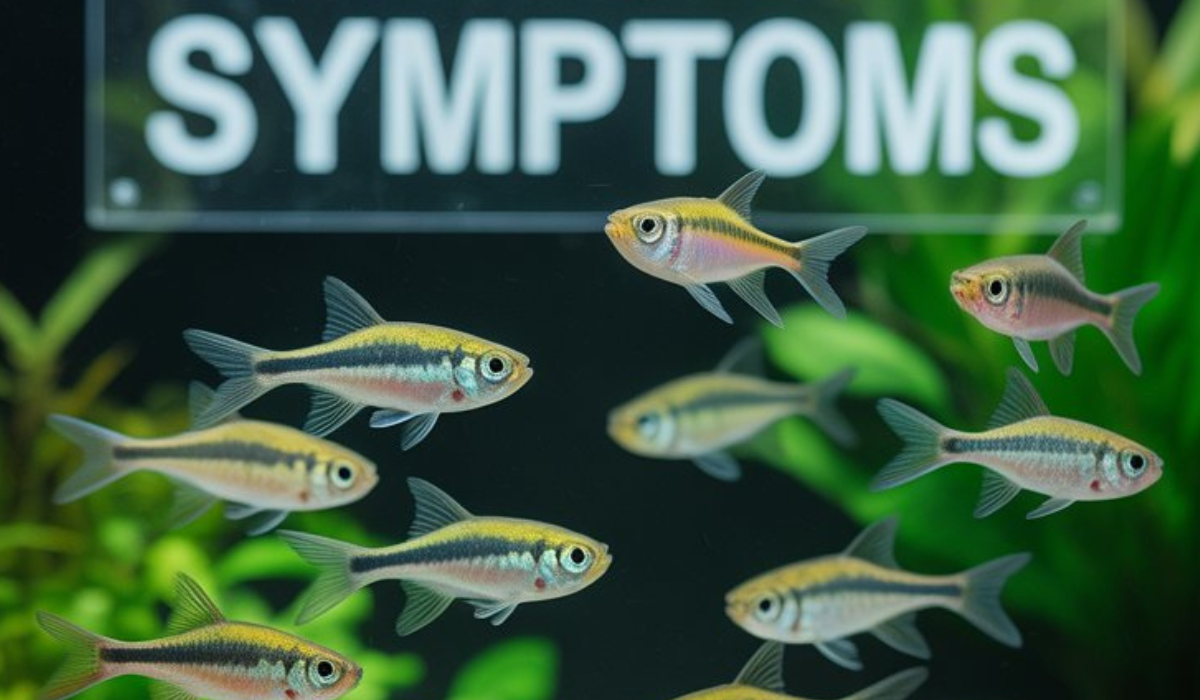If you’re an aquarium enthusiast, you probably love the vibrant blue and red glow of Neon Tetras. These tiny, peaceful fish are among the most popular choices for community tanks. However, one of the most concerning threats to their health is Neon Tetra Disease (NTD) — a highly contagious and often fatal condition that affects not only Neon Tetras but also other similar fish species.
Recognizing Neon Tetra Disease symptoms early is crucial. Once this disease sets in, it spreads rapidly and can devastate your aquarium if not managed properly. This comprehensive guide explains everything you need to know about the symptoms, causes, diagnosis, and prevention of Neon Tetra Disease — helping you protect your fish before it’s too late.
What Is Neon Tetra Disease?
Neon Tetra Disease (NTD) is a parasitic infection caused by the microsporidian parasite Pleistophora hyphessobryconis. It was first identified in Neon Tetras, hence the name, but it can affect many other freshwater fish species such as:
- Cardinal Tetras
- Rasboras
- Danios
- Angelfish
- Guppies
The disease primarily attacks the muscles, leading to severe tissue damage, loss of coloration, and eventual death. There is currently no known cure, which makes early detection and prevention absolutely essential.
How Neon Tetra Disease Spreads

NTD spreads mainly through ingestion of infected tissue. This typically happens when a healthy fish eats the remains of a dead or infected fish. Other possible routes of infection include:
- Contaminated water or equipment – using unclean nets, tanks, or siphons can transfer spores.
- Feeding live food that carries the parasite.
- Introducing infected new fish without proper quarantine.
Once inside a fish’s body, the parasite invades muscle tissue, forming cysts and causing massive cellular damage.
Neon Tetra Disease Symptoms: Early and Advanced Stages
Recognizing Neon Tetra Disease symptoms early can help prevent its spread to other fish. Below are the progressive signs to look out for:
1. Loss of Color (Fading or Dullness)
One of the earliest and most recognizable symptoms is loss of the bright neon coloration. The vibrant blue and red stripes of your tetras may appear faded, patchy, or dull. This discoloration often starts near the tail and spreads forward.
- Why it happens: The parasite destroys muscle tissues, disrupting the reflective pigments responsible for coloration.
- Tip: A sudden change in color without stress or lighting changes may signal infection.
2. Restlessness and Odd Swimming Behavior
Infected fish often become restless, isolating themselves from the group. You might notice them swimming erratically, darting, or hiding instead of schooling with others.
- Observation: Fish may struggle to maintain balance or swim in jerky motions.
- Reason: The parasite damages nerves and muscles, affecting motor control.
3. Difficulty Swimming or Loss of Coordination
As muscle tissue deteriorates, infected tetras may lose the ability to swim properly. They may float awkwardly, tilt sideways, or sink to the bottom.
This symptom often appears in the middle to late stages of infection and indicates severe internal damage.
4. Muscle Cysts or Lumps Under the Skin
Upon close inspection, you may see tiny white lumps or cyst-like spots under the fish’s skin. These are spore-filled cysts caused by the parasite multiplying inside muscle fibers.
- Location: Commonly seen near the dorsal or caudal fin area.
- Significance: A clear sign of advanced Neon Tetra Disease.
5. Deformed Spine or Bent Body
As the infection worsens, fish develop curved or twisted spines. This results from the parasite destroying muscle integrity and connective tissue.
- Commonly seen in: Older or severely infected tetras.
- Note: A bent spine can also indicate other conditions, but in combination with fading color, it strongly points to NTD.
6. Difficulty Eating or Loss of Appetite
Infected fish gradually lose interest in food. They may attempt to eat but spit out food or ignore it completely.
- Effect: Leads to rapid weight loss and weakness.
- Tip: A sudden appetite drop in a usually active tetra is an early red flag.
7. Secondary Infections
NTD weakens a fish’s immune system, making it vulnerable to secondary bacterial or fungal infections.
You may notice:
- White cottony growths (fungal infections)
- Frayed fins
- Red patches or sores on the skin
These are often a result, not the cause, of the underlying parasitic infection.
8. Isolation from the School

Healthy Neon Tetras usually move in coordinated schools. An infected fish tends to separate itself, staying near the bottom or hiding behind decorations.
This behavior helps you identify affected individuals before the disease spreads further.
9. Rapid Breathing and Lethargy
As the parasite damages muscles, including those used for respiration, fish may breathe rapidly or gasp for air.
Over time, the fish becomes weak, spends more time resting, and shows lethargic behavior.
Summary of Neon Tetra Disease Symptoms
| Stage | Visible Symptoms | Internal Effects |
|---|---|---|
| Early Stage | Slight color fading, reduced appetite | Initial parasite invasion in muscle cells |
| Mid Stage | Restlessness, isolation, erratic swimming | Muscle tissue breakdown, cyst formation |
| Late Stage | Bent spine, lumps under skin, loss of control | Widespread tissue damage, secondary infections |
| Terminal Stage | Extreme weakness, color loss, death | Organ failure, severe parasite load |
Diseases Similar to Neon Tetra Disease
Some conditions mimic NTD symptoms, making diagnosis challenging. Common look-alikes include:
1. False Neon Tetra Disease (Bacterial Infection)
Caused by bacteria rather than parasites. Symptoms may appear similar (loss of color, lethargy), but fish can recover with antibiotic treatment.
2. Columnaris (Cotton Mouth Disease)
A bacterial infection that creates white patches on the mouth and fins but doesn’t cause muscle cysts or bent spines.
3. Mycobacteriosis (Fish TB)
Chronic bacterial infection causing weight loss and spinal deformity. It develops slowly compared to NTD.
4. Poor Water Quality or Stress
Environmental factors like ammonia spikes can dull fish color or reduce activity — but these symptoms improve once conditions are corrected.
Tip: If multiple fish show signs rapidly after adding new fish or live food, suspect Neon Tetra Disease first.
How to Diagnose Neon Tetra Disease
Since many symptoms overlap with other infections, a microscopic examination is the only way to confirm NTD.
Diagnosis Methods:
- Microscopy: Tissue samples (usually muscle) are examined under a microscope for spores of Pleistophora hyphessobryconis.
- Behavioral Observation: Rapid progression, muscle lumps, and spine curvature are key signs.
- Post-Mortem Examination: Dead fish may show pale, necrotic muscle tissue.
Veterinarians or fish disease specialists can perform these tests for confirmation.
Treatment Options: Is Neon Tetra Disease Curable?

Unfortunately, there is no known cure for Neon Tetra Disease once a fish is infected. However, early intervention can contain the spread and protect healthy fish.
1. Quarantine Infected Fish Immediately
Remove affected fish to a separate hospital tank as soon as you notice symptoms. This prevents others from eating infected tissue.
2. Euthanize Severely Infected Fish
If the fish shows severe curvature or cysts, humane euthanasia may be the best option to protect the tank’s population.
3. Disinfect Aquarium Equipment
Clean nets, siphons, and tanks with a mild bleach solution (1 part bleach to 10 parts water). Rinse thoroughly before reuse.
4. Maintain Optimal Water Quality
Healthy water parameters can help unaffected fish resist infection:
- Temperature: 72–78°F (22–26°C)
- pH: 6.5–7.0
- Ammonia & Nitrite: 0 ppm
- Nitrate: <20 ppm
5. Support Immune Health
Feed remaining fish high-quality, vitamin-enriched foods like brine shrimp, daphnia, or fortified flakes.
6. Avoid Live Foods from Unknown Sources
Live food can carry parasites that trigger outbreaks. Use frozen or cultured live food to reduce risk.
Prevention: How to Protect Your Fish from Neon Tetra Disease
Because Neon Tetra Disease cannot be cured, prevention is your best line of defense. Here are essential tips:
1. Quarantine New Fish
Always isolate new arrivals for 2–4 weeks before adding them to your main tank. Watch for color fading or erratic swimming during this period.
2. Avoid Feeding Wild-Caught Live Foods
Only use live foods from trusted aquarium suppliers or culture your own. Wild live food can easily carry the parasite.
3. Maintain Clean Water
Perform regular partial water changes (25–30%) weekly. Use a reliable filter system and test water parameters frequently.
4. Remove Dead Fish Immediately
Never allow dead fish to decompose in the tank — they can spread infectious spores rapidly.
5. Disinfect Equipment and Decorations
Before introducing new plants or decor, rinse them in a mild disinfectant solution or quarantine separately.
6. Reduce Stress
Stress weakens fish immunity, making them more susceptible.
- Avoid overcrowding
- Keep temperature stable
- Minimize sudden lighting or pH changes
7. Feed a Balanced Diet
Provide nutrient-rich foods like frozen bloodworms, flakes, and algae wafers to strengthen immune systems.
8. Regular Observation
Spend a few minutes each day observing your fish. Early signs such as color changes or odd swimming often appear before severe infection sets in.
Fish Species Susceptible to Neon Tetra Disease
While the disease is named after Neon Tetras, several other species are vulnerable:
| Susceptible Species | Why Vulnerable |
|---|---|
| Cardinal Tetra | Similar body structure and feeding habits |
| Glowlight Tetra | Shares same water environment |
| Angelfish | Can ingest spores by eating infected fish |
| Danios & Rasboras | Active schooling behavior increases spread |
| Guppies & Mollies | Opportunistic feeders, may consume infected tissue |
Can Humans Get Neon Tetra Disease?
No. Neon Tetra Disease does not infect humans.
However, always wash your hands after handling fish tanks or deceased fish to avoid bacterial contamination.
Long-Term Tank Management After an Outbreak
Once NTD affects your tank, follow these steps to restore balance:
- Remove and euthanize infected fish.
- Perform a 70–80% water change.
- Clean all decorations and substrate thoroughly.
- Disinfect the tank and filter system.
- Allow the tank to run empty for 2–3 weeks before adding new fish.
- Reintroduce healthy, quarantined fish gradually.
This ensures no residual spores remain in the environment.
How to Differentiate Between Stress and Neon Tetra Disease
| Indicator | Stress | Neon Tetra Disease |
|---|---|---|
| Color Fading | Temporary; recovers after rest | Permanent, progressive fading |
| Swimming Behavior | Brief darting during changes | Continuous, erratic swimming |
| Appetite | Returns quickly | Gradual and total loss |
| Schooling | Still interacts with group | Isolates completely |
| Visible Cysts or Spine Curvature | Absent | Present in mid/late stages |
Conclusion
Neon Tetra Disease is one of the most serious and heartbreaking infections for aquarium keepers. Its symptoms — fading color, erratic swimming, muscle lumps, and bent spines — often appear gradually but progress rapidly once the parasite takes hold.
Since there is no cure, prevention is vital. By maintaining clean water, quarantining new fish, avoiding wild live food, and observing your fish daily, you can significantly reduce the risk of infection.
Remember, a little vigilance goes a long way in ensuring your Neon Tetras remain vibrant, healthy, and thriving in your aquarium.
FAQs About Neon Tetra Disease Symptoms
1. What is the first sign of Neon Tetra Disease?
The earliest symptom is usually color fading — especially a dull or patchy appearance in the neon blue or red stripe.
2. Can Neon Tetra Disease be cured?
Unfortunately, there is no known cure for Neon Tetra Disease. Prevention and early isolation are the best defenses.
3. How fast does the disease spread?
It spreads rapidly — within days — especially if fish eat infected tissue or share contaminated water.
4. How do I prevent Neon Tetra Disease in my tank?
Quarantine new fish, maintain water quality, and avoid feeding wild live food. Remove dead fish immediately.
5. Is Neon Tetra Disease contagious to other fish species?
Yes. Many small freshwater fish, including Cardinal Tetras and Rasboras, can become infected.
6. Can antibiotics treat Neon Tetra Disease?
No. Antibiotics work against bacteria, but NTD is caused by a parasite, not bacteria.
7. How can I tell if it’s stress or disease?
Stress symptoms usually disappear once conditions improve. Disease symptoms worsen over time and include cysts or deformities.
8. What should I do with infected fish?
Isolate immediately. If severely affected, consider humane euthanasia to prevent spreading.
9. Can Neon Tetra Disease survive in an empty tank?
Yes, spores can survive for weeks. Disinfect thoroughly and let the tank rest for 2–3 weeks before adding new fish.
10. Can humans catch Neon Tetra Disease?
No. It only affects fish, not humans. Still, always wash hands after handling aquarium water.

